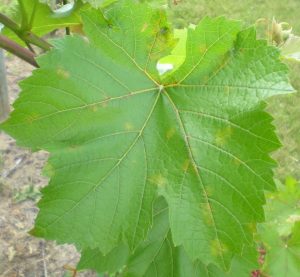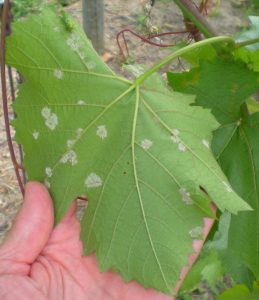Published on
Updated on
Contents:
- Signs of Stress from Drought
- Wetting Period of Morning Dews and Downy Mildew
- Sour Rot Management — Start Thinking Ahead
- High Air Temperatures and Pesticide Phytotoxicity
- Report Herbicide Drift Damage to Grape Crop to Missouri Department of Agriculture
- Cumulative Growing Degree Days for the Seven Grape Growing Regions of Missouri from April 1 to July 17, 2023
Signs of Stress from Drought
Vineyards that have not received adequate rainfall and are dryland farmed are showing signs of stress. Lack of water in and around the roots reduces the amount of nutrients available to the grapevine. This occurs since water is needed to dissolve the nutrients into a solution that then are available by the grapevine roots for uptake. Lack of rainfall resulting in drought conditions over prolonged periods ultimately results in nutrient deficiencies.
As the grapes enter veraison, it is important to maintain the canopy to shade developing grape clusters. Future weather forecasts are predicting some high heat days, which may sunburn developing clusters directly exposed to direct sunlight. There is a fine balance between removing too many basal leaves near clusters and exposing grapes to high heat and sunlight that can sunburn the developing grape berries. Based on north to south row orientation, some growers will remove basal leaves on the East side of the grapevines. This results in light exposure to morning and early afternoon sunlight. I would advise limiting leaf removal on the west side of grapevines since clusters are exposed to mid-afternoon through sundown sun exposure, which is the hottest part of the day. If your vineyards are under drip irrigation or have received adequate rainfall, then adjust accordingly. You need to take into account the vineyard site, canopy development, and the grape cultivar as you adjust the canopy during drought stress conditions.
Newly established vineyards
In newly established vineyards in drought-stricken areas, it is important to keep the developing grapevines adequately watered. In essence, a newly planted vineyard needs about one inch of rainfall or irrigation per week. The first three years of a grapevines establishment is critical for root growth and development.
Newly established drip irrigation
It is critical that your irrigation system delivers the correct amount of water over time. An easy way to determine if your irrigation system is working correctly is to place pails under emitters and collect water over a period of time. The pails should be placed randomly in rows throughout the zone being irrigated. Be sure to place pails in the row that is furthest from the water source. Record the time the irrigation system was on and measure the volume of water in each pail. Common problems are water leaks and or air leaks at junctions that result in reduced water flow. Another common problem is plugged emitters. If you are wondering how much water your system is applying you can use this drip line rate calculator.
Wetting Period of Morning Dews and Downy Mildew

Morning and evening temperatures, coupled with morning dew, continue to provide conditions for downy mildew infections. Ideal nighttime and morning temperatures of 65 to 77° F, humid nights, and frequent rains in some areas.
Hot daytime temperatures (>95° F) of recent and future weather forecasts will slow downy mildew growth and development. Most active downy mildew colonies are developing within the grape canopy where humidity is higher compared to leaves exposed to direct sunlight. Within these shaded canopies, the morning dew persists for a longer period of time and allows for secondary downy mildew infections.

Photo credit: D. S. Volenberg
Focus scouting for downy mildew in shaded areas. This may include border vineyard rows near wooded areas. Pay particular attention to scouting interior canopy leaves. The goal of scouting for any disease is to identify the disease and then apply management practices to reduce or eliminate secondary spread. If only two colonies of downy mildew are found on 50 grapevines then management practices need to be applied.
Active downy mildew infections should be controlled with a phosphorous acid fungicide. The phosphorous acid fungicide (Trade names are ProPhyt and Phostrol as examples) will “burn out” sporulating downy mildew colonies. Improved control can be enhanced by tank mixing a phosphorous acid fungicide with a protectant fungicide such as Captan. Remember that phosphorous acid fungicides only have activity against downy mildew. Do not apply more than two sequential applications of phosphorous acid fungicides. When active colonies are present, use the higher rate of phosphorous acid fungicide.
Grape berries develop resistance to downy mildew at the pea-size stage of development. All other green tissue remains susceptible to downy mildew infections. This includes the berry stems (pedicels). If the pedicels become infected with downy mildew, the hyphae can grow into the berry resulting in leather berry. Leather berry symptoms are a hard dry berry void of downy mildew colonies. The pedicels also develop age related resistance to downy mildew but resistance occurs two to three weeks after the berries develop resistance.
Besides applying protective fungicide sprays on a regular interval, get out and scout the vineyard. If you find two leaves with downy mildew colonies after scouting 50 vines, then you need to react. Minor or limited colony development can be cleaned up with an application of phosphorous acid fungicide. If rainfall and or weather conditions — heavy dew, cloudy and high humidity are predicted then consider a tank mix of phosphorous acid fungicide plus Captan. Be sure to check compatibility when tank mixing pesticide products. If you encounter a downy mildew explosion in the vineyard, do not apply strobilurin fungicides (Abound, Pristine, Sovran). Downy mildew has a propensity to develop resistance to strobilurins. Other fungicide options for managing downy mildew are listed in the table 1.
Table 1. Fungicides for control of downy mildew in grapes.
| Trade name | Common name | FRAC code | PHI (Days) | REI (Hours) |
|---|---|---|---|---|
| Aliette WDG | Aluminum tris | 33 | 12 | 15 |
| Captan 80 WDG | captan | M3 | 0 | 48 |
| Forum | dimethomorph | 40 | 14 | 12 |
| Ranman | cyazofamid | 21 | 30 | 12 |
| Reason | fenamidone | 11 | 30 | 12 |
| Revus | mandipropamid | 40 | 14 | 4 |
| Revus top | difenoconazole + mandipropamid | 3 + 40 | 14 | 12 |
| Tanos | famoxadone + cymoxanil | 11 + 27 | 30 | 12 |
| Topguard EQ | azoxystrobin + flutriafol | 3 + 11 | 12 | 14 |
| Zampro | ametoctradin + dimethomorph | 45 +40 | 14 | 12 |
| Ziram | Ziram | M3 | 48 | 21 |
Sour Rot Management — Start Thinking Ahead
Research out of Cornell by Greg Loeb and Katie Gold suggests the following:
- Start monitoring your vineyards for sour rot once the grapes attain 12 brix
- Once berries attain 15 brix and wet rainy conditions persist, coupled with warm temperatures, this should be a red flag that sour rot is likely.
- Warm evening temperatures between 68 to 77° F, coupled with rainy conditions when berries attain 15 brix, should also be cause for alarm
- Sour rot initiates on wounded berries in which the berry skin has been damaged. Although some evidence suggests that berry wounding occurs in tight clustered cultivars such as Vignoles, simply due to the cluster architecture. There are other entries for sour rot such as hail damaged berries, grape berry moth larvae, or mechanical damage to berries from mechanized leaf thinning, canopy management etc.
- The application of Oxidate plus an insecticide staring at 15 brix — followed by a second application prior to harvest — is as effective in controlling sour rot as compared to four applications.
- Alternate chemical classes of insecticides. Fruit flies in New York as well as Missouri have developed resistance to three different chemical classes of insecticides. These insecticides are Assail (Neonicotinoids), malathion (Organophosphates) and Mustang Maxx (Pyrethroid/Pyrethrins)
- The fruit fly populations resistant to three chemical classes of insecticides remain susceptible to Delegate (spinetoram).
- Starting a sour rot management program after symptoms appear is not as effective as starting a pre-emptive sour rot management program prior to sour rot symptom development.
Take home:
Monitoring the fruit brix, berry skin integrity, being aware of the weather conditions and timing the spray applications are key to sour rot management. Being pre-emptive can help reduce sour rot and save you dollars on pesticide applications.
High Air Temperatures and Pesticide Phytotoxicity
- Common fungicides such as copper products, sulfur products, and captan can cause phytotoxicity, but seldom will they cause phytotoxicity by themselves.
- Oils, adjuvants, stickers can enhance penetration of the pesticide through the cuticle. Urea applied as a foliar spray enhances pesticide penetration.
- High humidity conditions slow pesticide dry time and might enhance penetration.
- Temperatures over 90° F and sulfur applications can result in phytotoxicity, especially at high relative humidity that decrease drying time.
- Captan can become phytotoxic at high temperatures. Avoid spraying when temperatures are above 85° F.
- Mustang Maxx and emulsifiable concentrate can cause phytotoxicity when air temperatures are near or above 85° F.
- Adjuvants can heat up the spray mixture — be especially careful with your spray cocktail during high temperatures.
Report Herbicide Drift Damage to Grape Crop to Missouri Department of Agriculture
The Missouri Department of Agriculture keeps records of reported pesticide drift incidents. Grapevines are very sensitive to synthetic auxin herbicides which includes dicamba, 2,4-D and other herbicides. The last day that herbicides containing the active ingredient dicamba can be applied to dicamba tolerant soybeans in Missouri is June 30. The environmental protection agency works with states to approve additional labeling that may further restrict dicamba use in over the top applications. The EPA approved label restrictions for dicamba in 2022 in Iowa and Minnesota. For instance, in Iowa dicamba can not be applied over the top of dicamba-tolerant crops after June 20.
For more information on herbicide drift and symptoms from synthetic auxin herbicides, please see the article Herbicide Drift: What to do?
Cumulative Growing Degree Days for the Seven Grape Growing Regions of Missouri from April 1 to July 17, 2023
| Region | Location by County | Growing Degree Days1 | ||
|---|---|---|---|---|
| 2023 | 2022 | 30-year Average | ||
| Augusta | St. Charles | 1966 | 1964 | 1883 |
| Hermann | Gasconade | 1806 | 1808 | 1764 |
| Ozark Highland | Phelps | 2021 | 1961 | 1917 |
| Ozark Mountain | Lawrence | 1936 | 1931 | 1896 |
| Southeast | Ste. Genevieve | 1878 | 1912 | 1916 |
| Central | Boone | 1944 | 1882 | 1825 |
| Western | Ray | 1861 | 1786 | 1764 |
1 Growing degree days at base 50 from April 1 to July 17, 2023. Data compiled from Useful and Useable at https://mygeohub.org/groups/u2u/tools.
To determine the number of growing degree days accumulated in your area since April 1, use this tool.
Please scout your vineyards on a regularly scheduled basis in an effort to manage problem pests. This report contains information on scouting reports from specific locations and may not reflect pest problems in your vineyard. If you would like more information on IPM in grapes, please contact Dean Volenberg at 573-882-0476 (office) 573-473-0374 (mobile) or volenbergd@missouri.edu